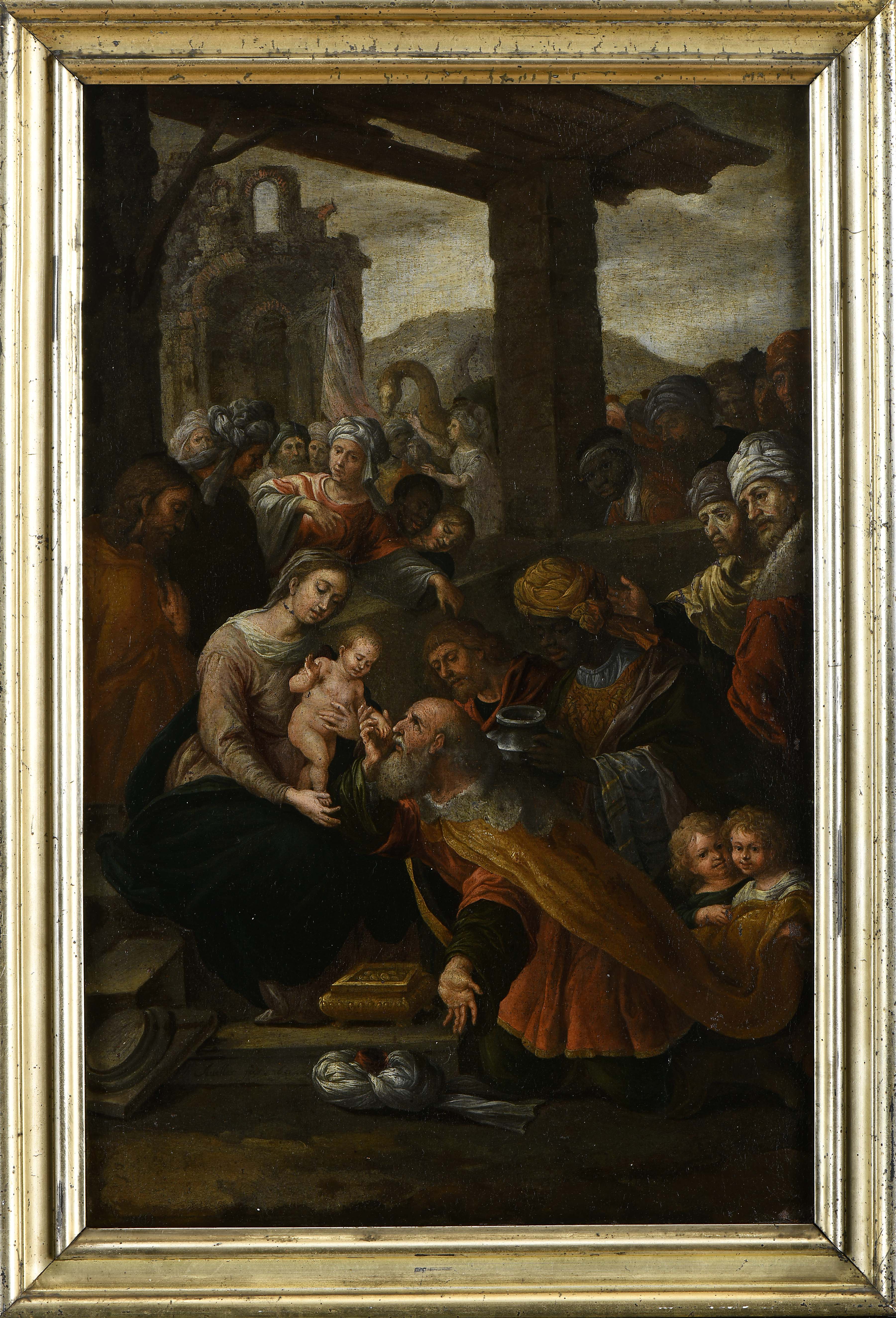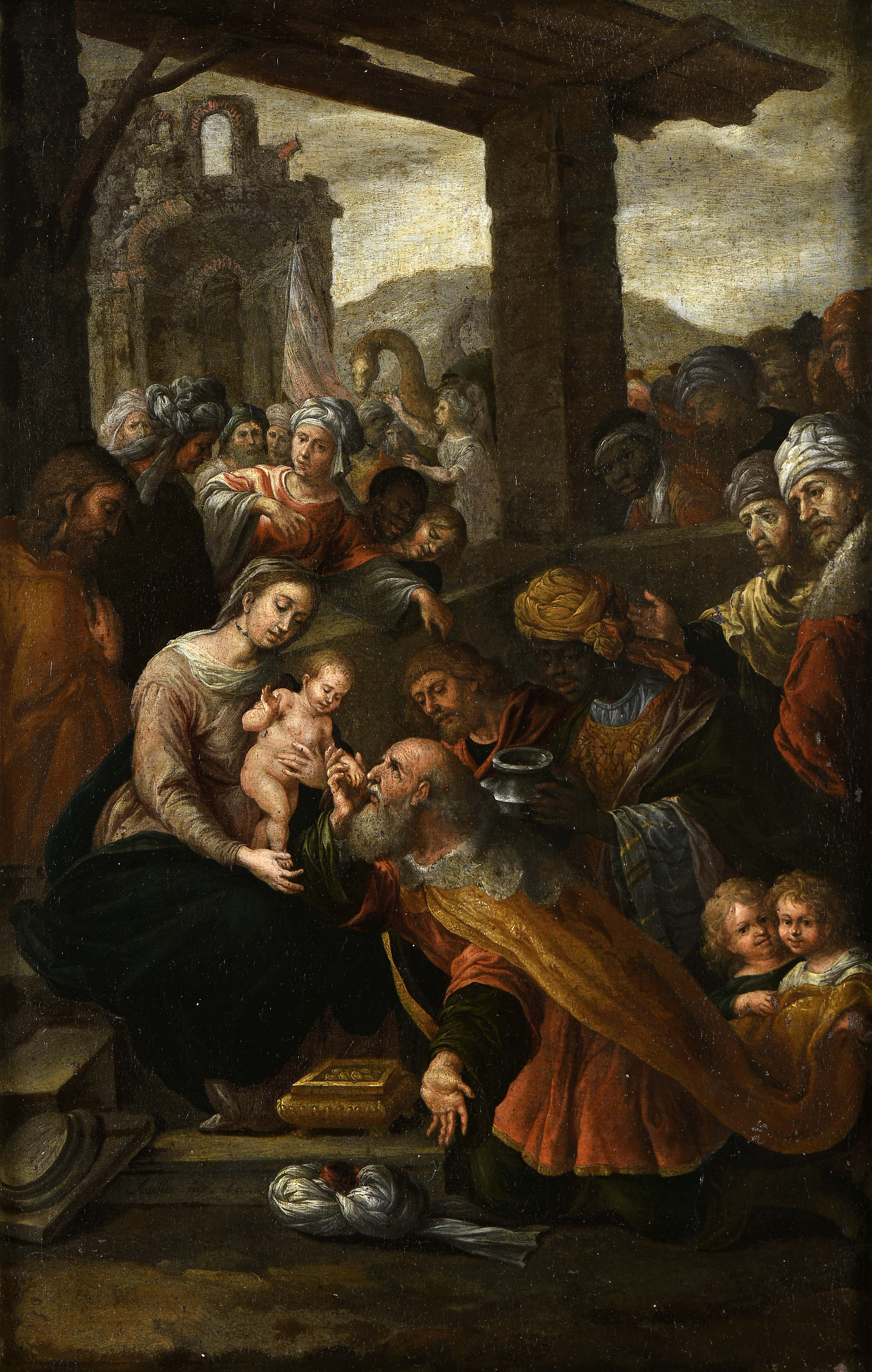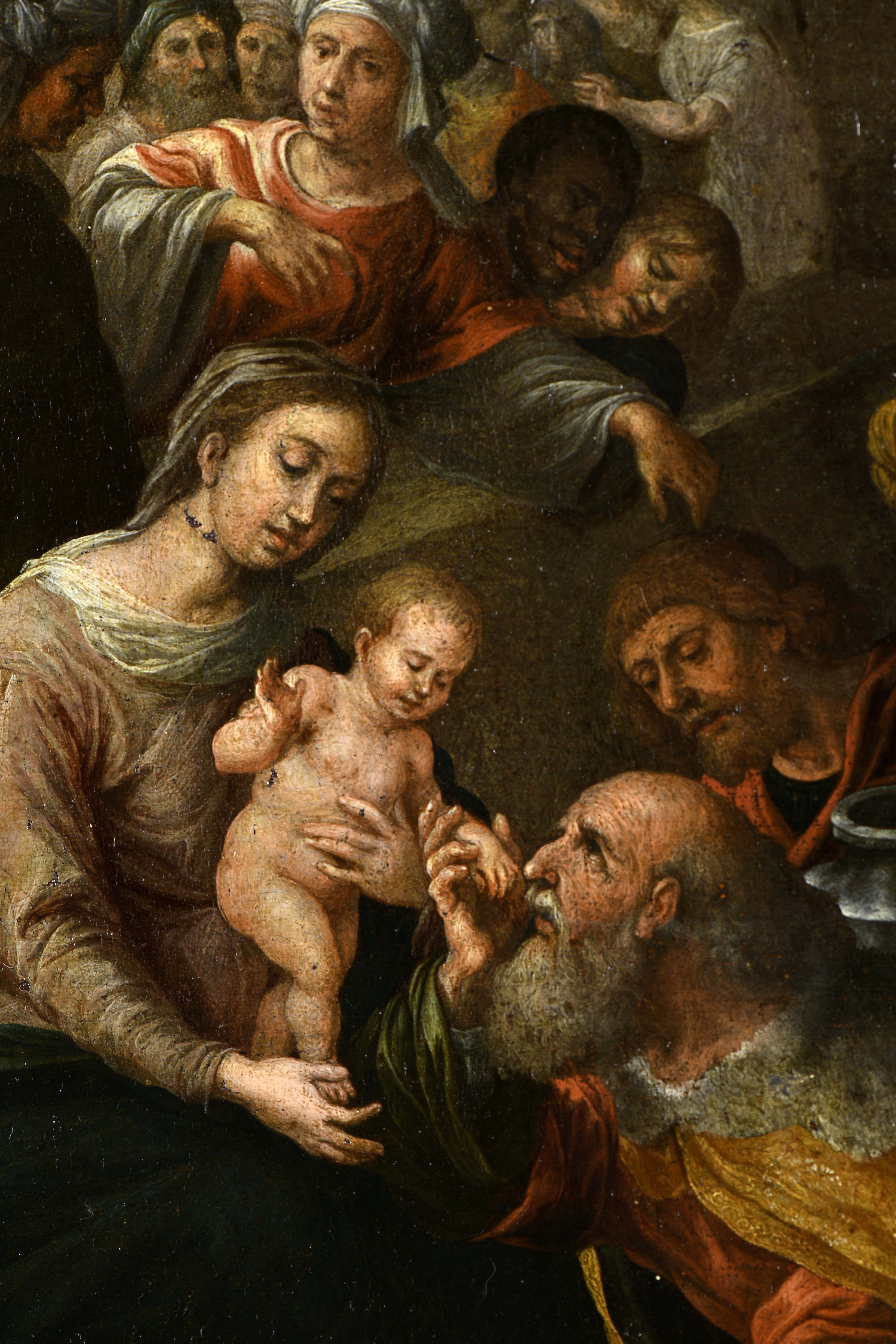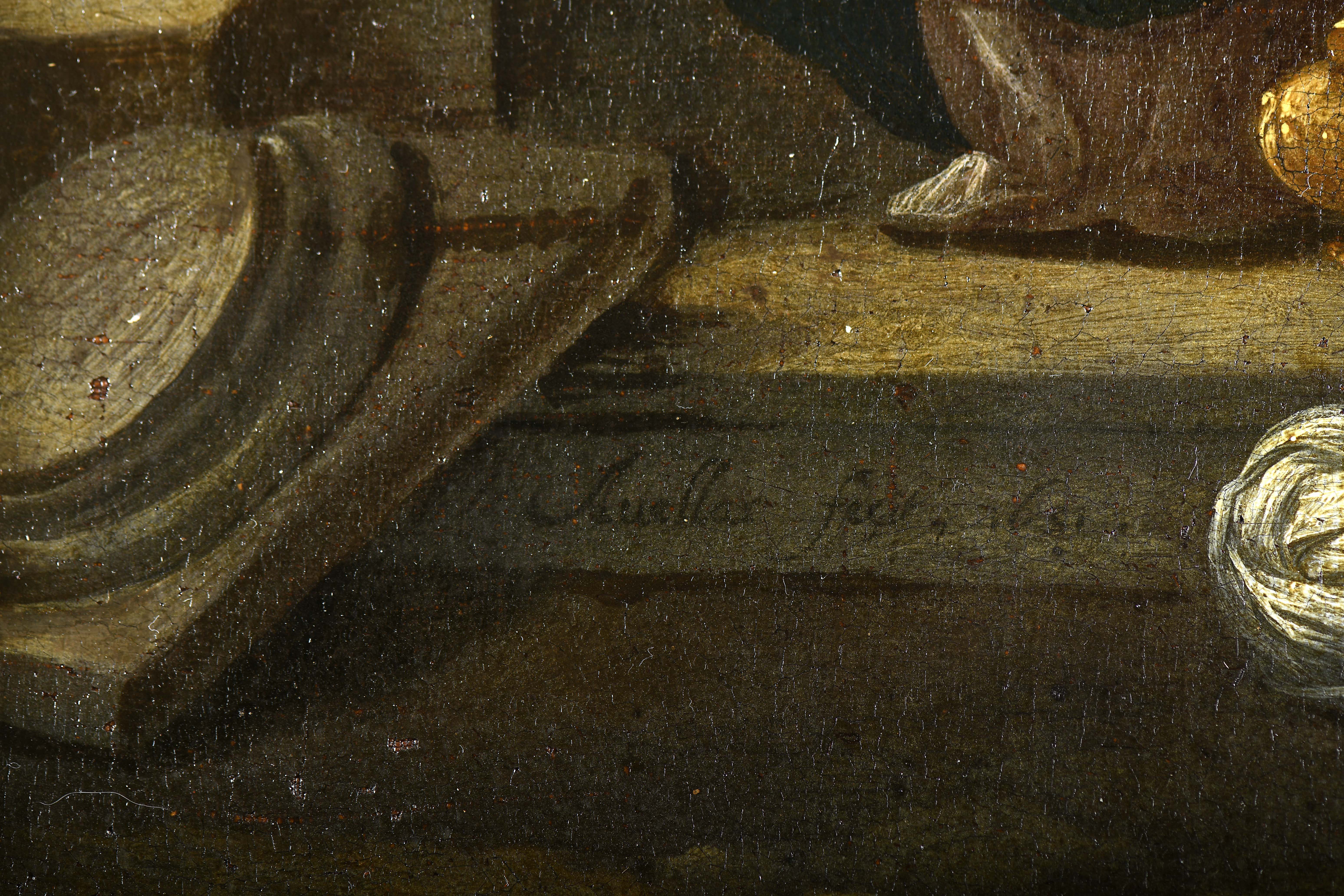81
JOSÉ DE AVELAR REBELO - c. 1600-1657
Description
JOSÉ DE AVELAR REBELO - c. 1600-1657, Adoration of the Magi, oil on canvas, relined, restoration, minor faults on the pictorial layer, signed and dated 1651. Notes: This panel of restricted dimensions by the royal painter José do Avelar Rebelo, which remained unknown to scholars, was completely unknown in the records of the History of Portuguese Art. It represents the Epiphany and is signed Avelar f. 1651. The artist, who was the royal painter of King D. João IV of Portugal and one of the most prominent names in the so-called Portuguese ''first proto-baroque generation'' (along with André Reinoso and Baltazar Gomes Figueira), shows in this painting all its design qualities and style personalism, in the path of a naturalistic language no longer reminiscent of the previous Mannerist tradition. For this small work, which has come down to us in an appreciable state of conservation, we can see the unanimous praise of his contemporaries and King D. João IV himself, «que folgava muito conversar com elle», as stated in the treatise by Félix da Costa Meesen. The king, who sometimes went to see him work and considered him «pintor de genio», wanted to honor him with the Habit of Knight of the Order of Saint Benedict of Avis, in 1655 for «ser o milhor pintor do seu tempo» and so that «outros à sua imitação o sigam». This last statement from the royal charter is very interesting, knowing how the good painters of the second half of the 17th century, especially Bento Coelho and also Marcos da Cruz, trained themselves in the study of Avelar's works, taking up his solutions and models. The theme represented, which shows a strong and unexpected Rubensian influence, was treated by Avelar in other works, one of them worthy of a laudatory poem by his friend Frei Tomás Aranha (Dominican orator and poet who in 1644 had written a sermon praising art painting). The poem, dedicated to a painting by Avelar with the same scene from the Magi, which King D. João IV had commissioned from him, says the following: «Soberano pinzel / tu te condenas / A não pintar jamais, pois que chegaste / Rei dos pinzeis, nos Reis, que nos mostraste / Onde chega o juizo humano apenas. / Das linhas de Protogenes ordenas / Grossos cordeis, nas linhas que lançaste / E em garrote d'invejas lhe trocaste / O sutil, em borrões, a gloria, em penas. / Tudo contemplo Trino em teus primores: / Painel de tres, Pintor, Rei, verdadeiro / Monarcha, em te occupar, contigo humano, / Elle imita tres Reis, tu tres pintores, / Elle Affonso, Manuel, & João Primeiro, / Tu, Miguel, Raphael, & Ticiano». It is difficult, in fact, to write a greater poetic praise for a painter and a painting, such as this one in which, with baroque but justifiable exaggeration, Avelar is compared to Raphael, Michelangelo and Titian! Another passionate poet from the academies of the Restoration period, António Leitão de Faria, also speaks of Avelar (and Reinoso) in a collection of poetry from 1706, in this encomiastic praise: «...Pare, pois, a Fama os voos e suspenda as vozes com que engrandece e louva por todas as partes do mundo, por todos os climas do universo, os quadros e as obras de Amplino, de Aristides, de Ardeas, de Asclopiodoro, de Persico, de Euricledes, de Niceas, de Timantes, de Ticiano, de Reinoso e de Avelar e, finalmente, cessem esses varões que a fama canta, que outro valor mais alto se levanta»... The composition, within the canons of proto-baroque Naturalism in which it is inserted (and which was the dominant taste in Portuguese painting in these years of crisis, due to the wars with Castile), attests to clear drawing merits, with a broad sense of the spaces of the composition , good relationship of plans and, above all, excellent figure modeling, with very expressive heads, poses and gestures. The composition must be inspired by an engraving by Lucas Vorstermann according to Rubens. In chromatic terms, however, the canvas lacks that fresh luminous tonality of Reinoso (see the zurbaranesque Adoration of the Magi of São Roque), with Avelar Rebelo's chromatic register being more marked by a tenebrism of Nordic roots, which is accentuated especially in this canvas given the influence of Rubens’ model. This is one of Avelar's best pieces in the field of sacred art (along with "O Menino entre os Doutores" in the church of São Roque, the excellent Saint Jerome in the workroom of the Jerónimos monastery, the canvases on the ceiling of the high choir of the Madre de Deus monastery, and of the Conquest of Lisbon in the church of Pias, Ferreira do Zêzere), not forgetting that he was also a good court portraitist, fixing the image of some of the holders of the new power, like the portrait of the famous musician Rebelinho, and like the ones he made of his king (Vila Viçosa Palace and National Coach Museum). The origin of the painting is unknown. Due to its theme, dimensions and chronology, it is very possible that this painting was part of an altarpiece intended for a private oratory, with courtly clientele. Who knows if it was part of the same altar with a Marian theme that included a painting of a circunsisão do menino (which not only measures 55 x 35 cm but is also signed Avellar f. 1651): this painting, whose state of conservation shows greater wear and loss of value, it also has a lot of historical-artistic interest and was traded a few years ago on the antiques market (Oportunity Leilões, Cascais, lot 5147). Vítor Serrão Art Historian, Dim. - 55,5 x 35,5 cm
Auction Details
Shipping
T&Cs & Important Info
Ask seller a question
JOSÉ DE AVELAR REBELO - c. 1600-1657, Adoration of the Magi, oil on canvas, relined, restoration, minor faults on the pictorial layer, signed and dated 1651. Notes: This panel of restricted dimensions by the royal painter José do Avelar Rebelo, which remained unknown to scholars, was completely unknown in the records of the History of Portuguese Art. It represents the Epiphany and is signed Avelar f. 1651. The artist, who was the royal painter of King D. João IV of Portugal and one of the most prominent names in the so-called Portuguese ''first proto-baroque generation'' (along with André Reinoso and Baltazar Gomes Figueira), shows in this painting all its design qualities and style personalism, in the path of a naturalistic language no longer reminiscent of the previous Mannerist tradition. For this small work, which has come down to us in an appreciable state of conservation, we can see the unanimous praise of his contemporaries and King D. João IV himself, «que folgava muito conversar com elle», as stated in the treatise by Félix da Costa Meesen. The king, who sometimes went to see him work and considered him «pintor de genio», wanted to honor him with the Habit of Knight of the Order of Saint Benedict of Avis, in 1655 for «ser o milhor pintor do seu tempo» and so that «outros à sua imitação o sigam». This last statement from the royal charter is very interesting, knowing how the good painters of the second half of the 17th century, especially Bento Coelho and also Marcos da Cruz, trained themselves in the study of Avelar's works, taking up his solutions and models. The theme represented, which shows a strong and unexpected Rubensian influence, was treated by Avelar in other works, one of them worthy of a laudatory poem by his friend Frei Tomás Aranha (Dominican orator and poet who in 1644 had written a sermon praising art painting). The poem, dedicated to a painting by Avelar with the same scene from the Magi, which King D. João IV had commissioned from him, says the following: «Soberano pinzel / tu te condenas / A não pintar jamais, pois que chegaste / Rei dos pinzeis, nos Reis, que nos mostraste / Onde chega o juizo humano apenas. / Das linhas de Protogenes ordenas / Grossos cordeis, nas linhas que lançaste / E em garrote d'invejas lhe trocaste / O sutil, em borrões, a gloria, em penas. / Tudo contemplo Trino em teus primores: / Painel de tres, Pintor, Rei, verdadeiro / Monarcha, em te occupar, contigo humano, / Elle imita tres Reis, tu tres pintores, / Elle Affonso, Manuel, & João Primeiro, / Tu, Miguel, Raphael, & Ticiano». It is difficult, in fact, to write a greater poetic praise for a painter and a painting, such as this one in which, with baroque but justifiable exaggeration, Avelar is compared to Raphael, Michelangelo and Titian! Another passionate poet from the academies of the Restoration period, António Leitão de Faria, also speaks of Avelar (and Reinoso) in a collection of poetry from 1706, in this encomiastic praise: «...Pare, pois, a Fama os voos e suspenda as vozes com que engrandece e louva por todas as partes do mundo, por todos os climas do universo, os quadros e as obras de Amplino, de Aristides, de Ardeas, de Asclopiodoro, de Persico, de Euricledes, de Niceas, de Timantes, de Ticiano, de Reinoso e de Avelar e, finalmente, cessem esses varões que a fama canta, que outro valor mais alto se levanta»... The composition, within the canons of proto-baroque Naturalism in which it is inserted (and which was the dominant taste in Portuguese painting in these years of crisis, due to the wars with Castile), attests to clear drawing merits, with a broad sense of the spaces of the composition , good relationship of plans and, above all, excellent figure modeling, with very expressive heads, poses and gestures. The composition must be inspired by an engraving by Lucas Vorstermann according to Rubens. In chromatic terms, however, the canvas lacks that fresh luminous tonality of Reinoso (see the zurbaranesque Adoration of the Magi of São Roque), with Avelar Rebelo's chromatic register being more marked by a tenebrism of Nordic roots, which is accentuated especially in this canvas given the influence of Rubens’ model. This is one of Avelar's best pieces in the field of sacred art (along with "O Menino entre os Doutores" in the church of São Roque, the excellent Saint Jerome in the workroom of the Jerónimos monastery, the canvases on the ceiling of the high choir of the Madre de Deus monastery, and of the Conquest of Lisbon in the church of Pias, Ferreira do Zêzere), not forgetting that he was also a good court portraitist, fixing the image of some of the holders of the new power, like the portrait of the famous musician Rebelinho, and like the ones he made of his king (Vila Viçosa Palace and National Coach Museum). The origin of the painting is unknown. Due to its theme, dimensions and chronology, it is very possible that this painting was part of an altarpiece intended for a private oratory, with courtly clientele. Who knows if it was part of the same altar with a Marian theme that included a painting of a circunsisão do menino (which not only measures 55 x 35 cm but is also signed Avellar f. 1651): this painting, whose state of conservation shows greater wear and loss of value, it also has a lot of historical-artistic interest and was traded a few years ago on the antiques market (Oportunity Leilões, Cascais, lot 5147). Vítor Serrão Art Historian, Dim. - 55,5 x 35,5 cm
Antiques and Works of Art
Sale Date(s)
Lots: 335
Venue Address
Rua Miguel Lupi 12-D
Lisbon
1200-725
Portugal
Noch keine Versandinformationen verfügbar.
Shipping information not yet avalable.
Important Information
Zu Aufgeld und Mehrwertsteuer prüfen Sie bitte das jeweilige Los.
For buyer’s premium and VAT please check particular lot.















